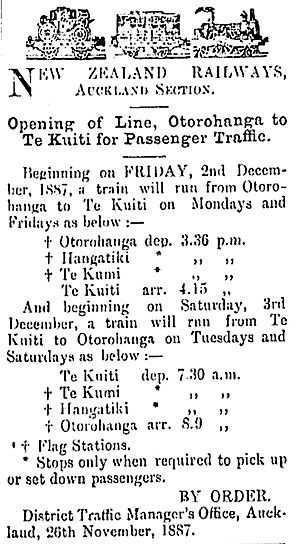Te Kumi railway station facts for kids
Quick facts for kids
Te Kumi railway station
|
|||||||||||
|---|---|---|---|---|---|---|---|---|---|---|---|

Te Kumi in 1885
|
|||||||||||
| Location | New Zealand | ||||||||||
| Coordinates | 38°18′32″S 175°09′06″E / 38.309000°S 175.151700°E | ||||||||||
| Elevation | 49 m (161 ft) | ||||||||||
| Line(s) | North Island Main Trunk | ||||||||||
| Distance | Wellington 479 km (298 mi) | ||||||||||
| History | |||||||||||
| Opened | 2 September 1887 goods 2 December 1887 passenger |
||||||||||
| Closed | 14 October 1968 | ||||||||||
| Electrified | June 1988 | ||||||||||
| Services | |||||||||||
|
|||||||||||
The Te Kumi railway station was once an important stop on the North Island Main Trunk railway line in New Zealand. Building this railway faced challenges. Some Māori groups did not want the railway to enter their lands, known as King Country. Te Kumi was one of the last places where this resistance was seen.
In 1879, some people from the Ngāti Kinohaku tribe were arrested at Parihaka. They were later returned to Te Kumi. There, they tried to create a similar community. In 1883, a surveyor named Charles Wilson Hursthouse was held at Te Kumi by a Māori leader named Te Mahuki. This happened while Hursthouse was surveying the land for the railway. Te Mahuki later posed for a photo at Te Kumi in 1885. This was after he had spent a year doing hard work as a punishment.
Contents
Opening and Features of Te Kumi Station
The Te Kumi railway station officially opened when the railway section from Ōtorohanga to Te Kuiti was finished. The companies Coates & Metcalfe built this part of the line, starting their work in 1886.
The station first opened for carrying goods on 2 September 1887. Three months later, on 2 December 1887, it opened for passengers. At first, only two trains came each week.
The railway spent about £122 to build a small shelter and a platform. This made Te Kumi a flag station. A flag station is a place where trains only stop if someone waves a flag to get on, or if a passenger on the train asks to get off there.
Over the years, more things were added to the station:
- In 1897, restrooms were built.
- In 1899, a goods shed was added. This was a building about 6.7 meters (22 feet) long and 4.3 meters (14 feet) wide. It was used to store goods being loaded or unloaded from trains.
- In 1905, yards for cattle and sheep were built. A passing loop was also added. This was an extra track that allowed trains to pass each other. It was long enough for 22 train wagons.
- In 1911, a loading bank was built. This made it easier to load and unload heavy items from trains.
- In 1920, houses for railway workers were built nearby.
Nearby Railway Sidings
There were two other important railway sidings near Te Kumi station. A siding is a short track connected to the main line. It is used for trains to wait or for loading and unloading goods.
Superfine Lime Siding
The Superfine Lime Siding was about 2.94 kilometers (1.8 miles) north of Te Kumi. This siding was used for many years, from at least 1937 until 1987. It helped transport lime, which is used in farming and other industries. Today, there is no longer a sign of this siding. However, lime is still transported from the nearby works by rail. This company is now owned by Omya.
Te Kuiti Lime Siding
The Te Kuiti Lime Siding was about 1.31 kilometers (0.8 miles) south of Te Kumi. This siding served a quarry that produced lime and other materials like gravel. The quarry was rebuilt in 1912 after a fire.
Today, only a single railway track and a small substation remain in the area.
External links
- Aerial photos in 1944 and 1963


